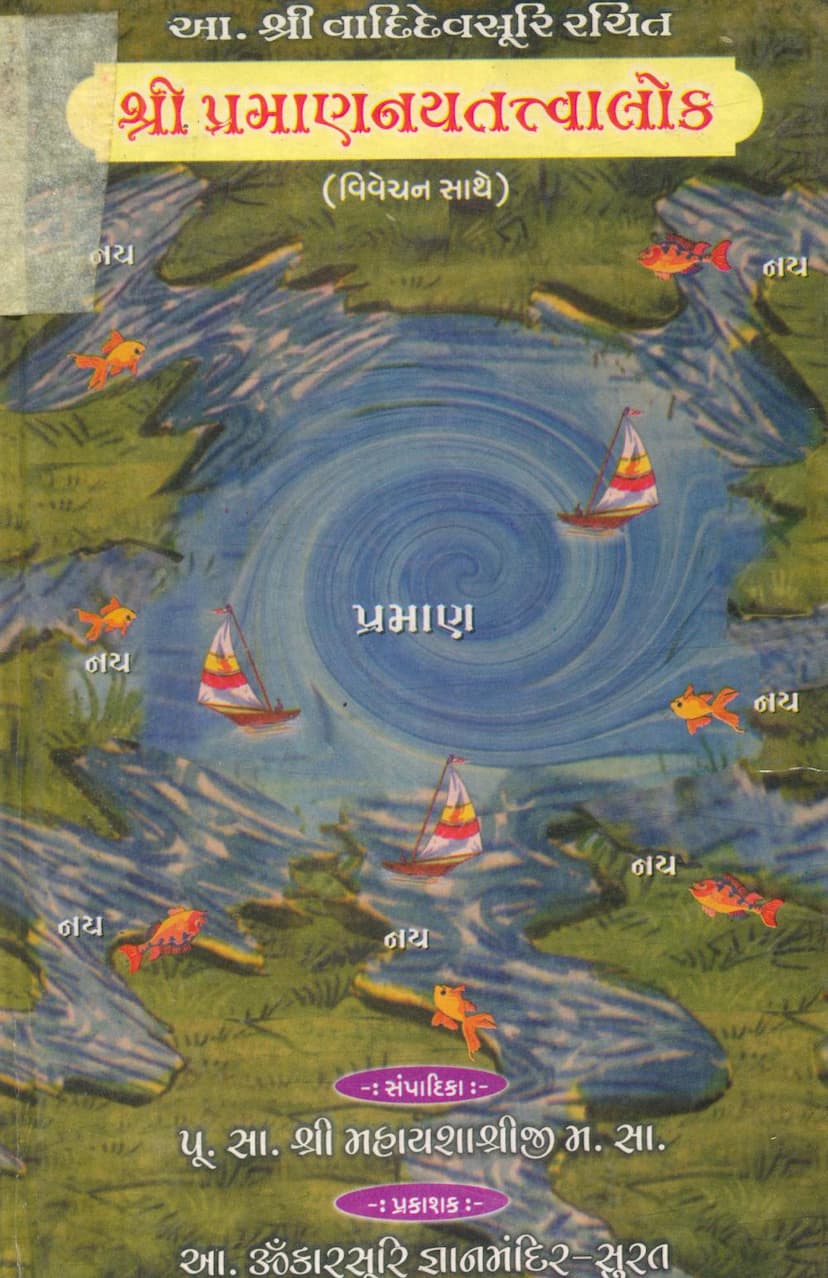Pramannaytattvalok
Added to library: September 2, 2025

Summary
Here is a comprehensive summary of the Jain text "Pramannaytattvalok" by Mahayashashreeji, based on the provided catalog link and the Gujarati text:
Book Title: Pramannaytattvalok (શ્રી પ્રમાણનયતત્ત્વાલોક) Author: Acharya Shri Vadidevasooriji Maharaj (આચાર્ય શ્રી વાદિદેવસૂરિજી મહારાજ) Commentary/Translation: Pandit Shri Ramgopalacharya (Pandit Shri Ramgopalacharya) (बालबोधिनी टीका) and Sadhvi Shri Mahayashashreeji (પૂ. સાધ્વીશ્રી મહાયશાશ્રીજી મ.સા.) (विशद गुजराती विवेचन) Publisher: Acharya Shri Omkarsuri Gyanmandir, Surat (આ. ૐકારસૂરિ જ્ઞાનમંદિર - સુરત)
Core Subject:
"Pramannaytattvalok" is a foundational text in Jain philosophy, specifically focusing on Pramana (Means of Valid Knowledge) and Naya (Standpoints/Approaches). The book aims to elucidate the intricate principles of Jain epistemology and logic, making them accessible to students and seekers of Jain philosophy.
Key Aspects and Content Summary:
The book, presented with a detailed Gujarati commentary and translation by Sadhvi Shri Mahayashashreeji, is based on the original work by Acharya Vadidevasooriji. The commentary by Pandit Ramgopalacharya is also integral. The text systematically explores the core tenets of Jain logic and metaphysics:
-
Introduction and Author's Context (Pages 1-7): The initial pages introduce the book and its publication, highlighting the efforts of Sadhvi Shri Mahayashashreeji. It expresses gratitude to the supporting trusts and individuals who made the publication possible. The editorial section emphasizes the book's importance as an introductory text for understanding Jain logic and the meticulous work done in translating and commenting on it. It also delves into the profound significance of the original work and the scholarly effort behind its presentation.
-
The Author, Acharya Vadidevasooriji (Pages 10-17): The text provides a detailed biographical sketch of Acharya Vadidevasooriji. It recounts his birth in Mandar, his exceptional qualities even in childhood, his initiation into the monastic order, his extensive studies under great scholars like Acharya Shantishuriji, and his eventual consecration as an Acharya. His intellectual prowess is demonstrated through accounts of his debates with prominent philosophers of his time, including his victory over Digambara scholars. His extensive literary contributions, including "Pramannay Tattvalok" and "Syadvada Ratnakara," are also mentioned.
-
The Book: Pramannaytattvalok (Pages 9, 21-26):
- Uniqueness: The book is described as a unique treatise on Pramana, drawing from the entirety of Shvetambara and Digambara Jain literature available up to the author's time. Its language is lauded for its clarity and accessibility, making complex logical arguments enjoyable.
- Structure: The work is structured into eight chapters (Parichhed), containing 378 sutras (aphorisms).
- Content Overview: It discusses the five types of knowledge, elaborates on the two main types of Pramana (Pratyaksha and Paroksha), and delves into the logical foundations of these concepts. It also covers topics like the nature of valid knowledge (Praman), invalid knowledge (Apraman), the characteristics of Pramana, and the causes and refutations of logical fallacies. The text also explores the concept of Naya (standpoints) and its various classifications, including the famous Sapta-bhangi (Seven-fold Standpoint) and its philosophical underpinnings.
-
Detailed Explanation of Pramana (Manifested in the Summary of Chapters 1-6):
- Definition: Pramana is defined as knowledge that is free from doubt and accurately grasps both its own nature and the nature of the object (Sva-para-vyavsaayi-jnanam).
- Types: Pramana is primarily divided into Pratyaksha (Direct) and Paroksha (Indirect).
- Pratyaksha: Explained with its direct sensory and mental manifestations, and then further classified into Saamyavaharika (Conventional) and Paramarthika (Ultimate). Saamyavaharika Pratyaksha includes knowledge derived from senses and mind, while Paramarthika Pratyaksha encompasses Avadhijnana, Manahparyayajnana, and Kevalajnana (omniscience).
- Paroksha: This includes Smriti (Memory), Pratyabhijnana (Recognition), Tarka (Reasoning), Anumana (Inference), and Agama (Scriptural Testimony). The text meticulously explains each of these, their definitions, examples, and logical underpinnings. It also discusses various types of fallacies (Prati-bhasa) that can arise in these means of knowledge.
-
Detailed Explanation of Naya (Manifested in the Summary of Chapters 7):
- Definition: Naya is defined as a particular standpoint or perspective from which a subject is viewed, focusing on one aspect while temporarily setting aside others.
- Types: The text explains the two primary classifications of Naya:
- Dravyarthika Naya: The standpoint that focuses on the substance or essence of a thing, often viewing things from a broader, more permanent perspective.
- Paryayarthika Naya: The standpoint that focuses on the modes, changes, or transient aspects of a thing.
- Sub-classifications: Both Dravyarthika and Paryayarthika Nayas are further elaborated with their respective sub-types (e.g., Nigama, Sangraha, Vyavahara, Rujusutra, Shabda, Samabhiruḍha, Evambhuta) and their associated fallacies (Naya-bhasa).
- Sapta-bhangi: A significant portion is dedicated to the Sapta-bhangi (Seven-fold Standpoint), explaining its structure and philosophical significance in representing the multi-faceted nature of reality according to Jainism, where propositions are qualified with "Syat" (Perhaps/In a certain respect).
-
Debate (Vada) and Its Elements (Chapter 8): The final chapter discusses the nature of debate (Vada), its purpose (deciding truth), and its participants:
- Vadi (Debater): Can be driven by victory (Jigishu) or the desire for truth (Tattvanirninyishu).
- Prativadi (Opponent): Similar to Vadi, can be motivated by victory or truth.
- Sabha (Assembly): The audience or panel of scholars.
- Sabhapati (Presiding Officer): The moderator.
- The process of debate: The text outlines the structure, the rules, and the conditions under which a debate can proceed, including the number of members in the assembly and the roles they play. It also touches upon the qualifications of the participants and the process of establishing the validity of arguments.
Overall Significance:
"Pramannaytattvalok" is a critical work for understanding the analytical framework of Jainism. It demonstrates how different standpoints (Nayas), when used correctly, lead to valid knowledge (Pramana), but when misused or taken to an extreme, become fallacious (Abhasa). The book is highly valued for its systematic presentation of complex philosophical concepts, making it an indispensable resource for students of Jain philosophy and logic. Sadhvi Shri Mahayashashreeji's commentary ensures that the profound insights of Acharya Vadidevasooriji are accessible to a wider audience.